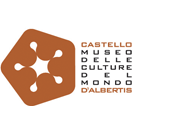Since October 2010, the donation of eleven photographs taken in North America by Douglas Beasley marks the opening of a new permanent section of the museum dedicated to the North American sacred landscape.
Hanging in the void of a double-height space that longitudinally crosses the 16th-century bastion and exposed to both sunlight and the darkness of night, these photos are linked to the ethnological collections of the Indians of the North American Plains and Hopi Indians of Arizona exhibited on the first floor of the bastio. These photos embrace the visitor, permeating the environment both physically and spiritually.
This installation reflects the philosophy of the photographer, who does not merely “take” photos, but rather creates them, aware that the earth encounters the spirit and that photography is a means to connect the world rather than separate us from what lies before our eyes.
Having been exposed for over 150 years to pictures depicting Indians as unruly and ruthless warriors who ride in the plains, as “sorcerers” who sing and dance in healing rituals, or as warrior chiefs posing between the camps of conical tents, at first glance Beasley’s photos may leave us bewildered before a desert landscape, desperately in search of recurring landmarks that, due to Hollywood film, we take for granted and automatically attribute to a stereotypical figure that we never questioned or grasped in its complexity and cultural, spiritual and historical depth.
Douglas Beasley has in fact made a choice: the images that are part of the project Sacred Sites of the Lakota Indians in the Blackhills and Badlands of South Dakota, to which most of the photos on display here belong, depict “just” natural places, such as mountains, trees, skies, or wind and storms, or places of worship or contact with spirits, such as circles of medicine, sudatory huts, pieces of cloth or flags tied to the branches of the trees…
In doing so, Douglas Beasley has chosen to honour North American Indians, depicting what is most sacred to them and what best expresses their values and spirituality: a landscape that is sacred because their ancestors lived there, because it was handed over by their ancestors and, above all, because it represents the ancestors themselves.
Website: www.douglasbeasley.com
Workshops: www.VQphoto.com
Blog: douglasbeasley.blogspot.com
List of the photos donated to the museum:
• "Road on top of Sheep Table", Badlands, South Dakota
• "Kiva, Bandelier", New Mexico
• "Road to Red Cloud’s Grave", Pine Ridge, South Dakota
• "Custer’s Battlefield", Montana
• "Ancient Tree", Black Hills, South Dakota
• "Bear Butte Holy Mountain of the Lakota and the Cheyenne", Bear Butte, South Dakota
• "Scenic Overlook", Badlands, South Dakota
• "Medicine Wheel", Bear Butte, South Dakota
• "Tobacco Prayer Ties in Tree", Bear Butte, South Dakota
• "Sweat Lodge", Sacred Mine of Pipestone Quarry, Minnesota
• "Corn Creek Massacre Site", South Dakota




